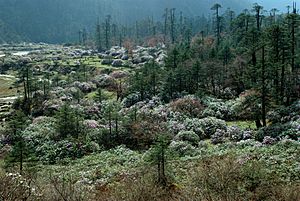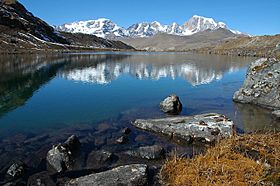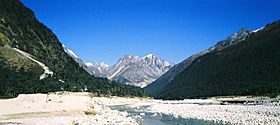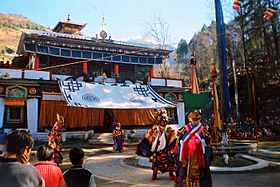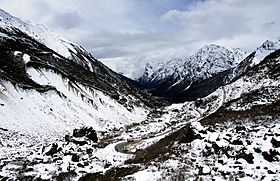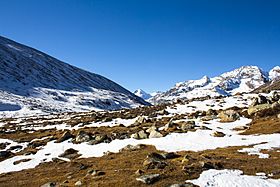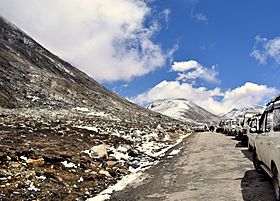Mangan district facts for kids
Quick facts for kids
Mangan district
|
|
|---|---|
|
District of Sikkim
|
|
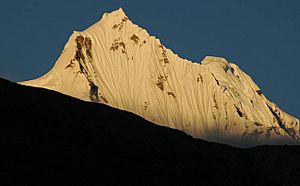
Kangchenjunga in Mangan district, Sikkim
|
|
| Country | |
| State | |
| Headquarters | Mangan |
| Area | |
| • Total | 4,226 km2 (1,632 sq mi) |
| Elevation | 610 m (2,000 ft) |
| Population
(2011)
|
|
| • Total | 43,709 |
| • Density | 10.3429/km2 (26.788/sq mi) |
| Time zone | UTC+05:30 (IST) |
| ISO 3166 code | IN-SK |
| Vehicle registration | SK-03 |
Mangan District, also known as North Sikkim, is a beautiful area in the Indian state of Sikkim. Its main town and headquarters is Mangan. It's one of the least populated districts in India, which means it has lots of open spaces and nature!
Contents
Exploring Mangan District's Geography
Mangan District is the largest of the four districts in Sikkim. It has a very mountainous landscape. You'll see thick forests that reach high up the mountains. As you go even higher, the trees become fewer, and the land turns into a desert-like area called tundra.
Many amazing waterfalls can be seen along the main roads. This makes traveling through the district very scenic. Because the valleys are so steep, landslides can happen. These are caused by melting snow or heavy rains.
Most people in the district live near Mangan, the main town. It is about 610 meters (2,000 feet) above sea level. As you travel further north, the land gets much higher. The plants change from those found in mild climates to those that grow in very cold, high-altitude areas.
Temperatures can range from about 25°C (77°F) to below -40°C (-40°F) in the highest parts. These extreme areas are over 6,000 meters (19,685 feet) high. Kangchenjunga, one of the world's highest peaks, is over 8,000 meters (26,247 feet) tall. It sits on the western border with Nepal and can be seen clearly from the town of Singhik.
Economy and Tourism in Mangan
Mangan is famous as the "Large Cardamom Capital of the world." The weather and land here are perfect for growing a big type of Cardamom. This spice is used in many dishes and drinks.
The region also has many power projects. These use the steep mountains and many lakes to create hydroelectric power. This means Mangan District usually has electricity all the time.
In 2006, the Indian government listed North Sikkim as one of the country's "most backward districts." This means it receives special funds to help it develop.
Visiting Mangan District
Much of North Sikkim is a restricted area for visitors. You need special permits to go to these places. This is because the area shares a sensitive border with China. The Indian army patrols it closely.
However, many tourists still visit because of the stunning natural beauty. It's important for visitors to help protect this delicate mountain environment.
Divisions of Mangan District
Mangan District is split into two main administrative areas called sub-divisions.
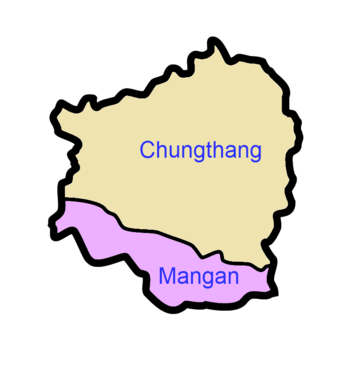
| Name | Headquarters | Number of villages | Location |
| Chungthang | Chungthang | 9 | |
| Mangan | Mangan | 46 |
People and Languages of Mangan
In 2011, Mangan District had a population of 43,709 people. This is about the same as the country of Liechtenstein. It is one of the least crowded districts in India. The district has 769 girls for every 1000 boys. About 77.39% of the people can read and write.
Most people in Mangan District are from the Lepcha and Bhutia groups. There is also a Tibetan community.
Religions in Mangan District
| Religion in Mangan district (2011) | ||||
|---|---|---|---|---|
| Buddhism | 53.35% | |||
| Hinduism | 34.05% | |||
| Christianity | 6.09% | |||
| Sikhism | 1.87% | |||
| Islam | 1.86% | |||
| Other or not stated (mainly Kirat Mundhum) |
2.8% | |||
Most people in Mangan District follow Buddhism. A good number of people also follow Hinduism.
Languages Spoken in Mangan
Many different languages are spoken in Mangan District. In 2011, the most common languages were Lepcha, Nepali, and Sikkimese. Other languages spoken include Limbu, Hindi, Sherpa, and Tamang.
Amazing Animals and Plants
Mangan District is home to the red panda (Ailurus fulgens). This animal is very special and is the State Animal of Sikkim. It is about 60 cm (2 feet) long, similar to a domestic cat. Red pandas have red fur, a triangular face, and a bushy tail. They usually live in trees at heights between 2,000 and 4,000 meters (6,500 to 13,000 feet).
In 1977, a large protected area called Khangchendzonga National Park was created in North Sikkim. This park covers about 1,784 square kilometers (689 square miles). It helps protect many different kinds of plants and animals. The district also has the Shingba (rhododendron) Wildlife Sanctuary, which was set up in 1984.
Important Towns and Cities
- Mangan
- Chungthang
- Lachen
- Lachung
- Phodong
- Dikchu
Banking Facilities
You can find banking services in Mangan District at these banks:
- Axis Bank, Lachen
- Central Bank of India, Mangan
- Canara Bank, Mangan
- IDBI Bank, Mangan
- State Bank Of India, Chungthang
- State Bank Of India, Mangan
- State Bank Of India, Kabi Sab
- State Bank Of India, Lachung
- State Bank Of India, Phodong
- State Bank Of India, Dikchu
- Union Bank of India, Mangan
- Uco Bank, Mangan
See also
 In Spanish: Distrito de Sikkim septentrional para niños
In Spanish: Distrito de Sikkim septentrional para niños


